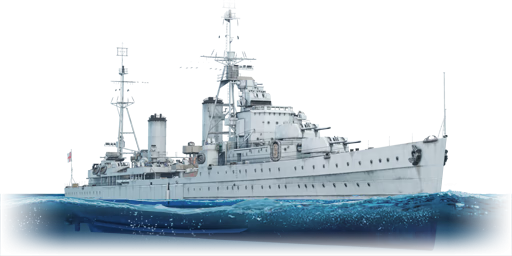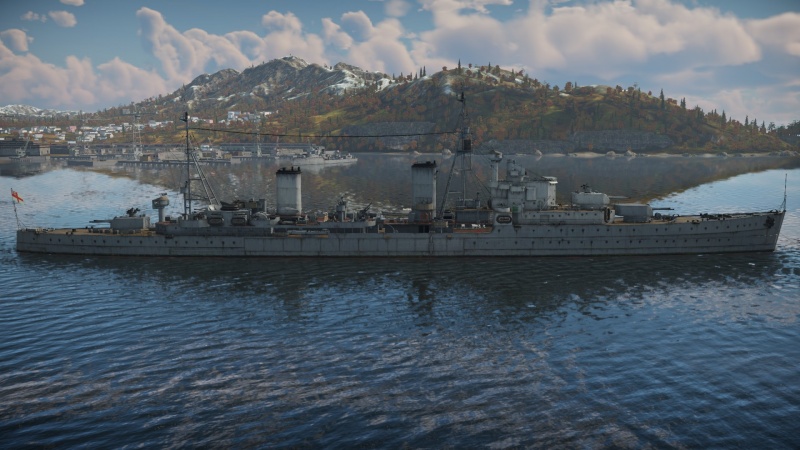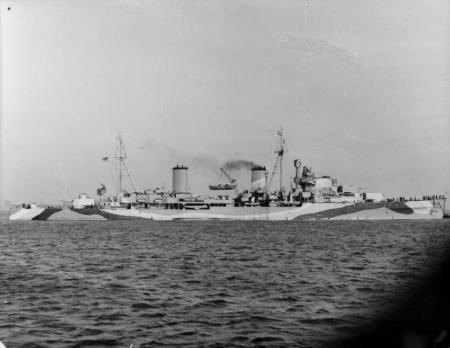HMS Arethusa
Contents
Description
The Arethusa-class, HMS Arethusa (26), 1943 is a rank III British light cruiser with a battle rating of 5.0 (AB) and 5.3 (RB/SB). It was introduced in Update 1.91 "Night Vision".
General info
Survivability and armour
Talk about the vehicle's armour. Note the most well-defended and most vulnerable zones, e.g. the ammo magazine. Evaluate the composition of components and assemblies responsible for movement and manoeuvrability. Evaluate the survivability of the primary and secondary armaments separately. Don't forget to mention the size of the crew, which plays an important role in fleet mechanics. Save tips on preserving survivability for the "Usage in battles" section. If necessary, use a graphical template to show the most well-protected or most vulnerable points in the armour.
Mobility
Write about the ship's mobility. Evaluate its power and manoeuvrability, rudder rerouting speed, stopping speed at full tilt, with its maximum forward and reverse speed.
| Mobility Characteristics | |||
|---|---|---|---|
| Game Mode | Upgrade Status | Maximum Speed (km/h) | |
| Forward | Reverse | ||
| AB | |||
| Upgraded | 66 | 30 | |
| RB/SB | |||
| Upgraded | 57 | 26 | |
Modifications and economy
Armament
Primary armament
Provide information about the characteristics of the primary armament. Evaluate their efficacy in battle based on their reload speed, ballistics and the capacity of their shells. Add a link to the main article about the weapon: {{main|Weapon name (calibre)}}. Broadly describe the ammunition available for the primary armament, and provide recommendations on how to use it and which ammunition to choose.
Secondary armament
Some ships are fitted with weapons of various calibres. Secondary armaments are defined as weapons chosen with the control Select secondary weapon. Evaluate the secondary armaments and give advice on how to use them. Describe the ammunition available for the secondary armament. Provide recommendations on how to use them and which ammunition to choose. Remember that any anti-air armament, even heavy calibre weapons, belong in the next section. If there is no secondary armament, remove this section.
Anti-aircraft armament
An important part of the ship's armament responsible for air defence. Anti-aircraft armament is defined by the weapon chosen with the control Select anti-aircraft weapons. Talk about the ship's anti-air cannons and machine guns, the number of guns and their positions, their effective range, and about their overall effectiveness – including against surface targets. If there are no anti-aircraft armaments, remove this section.
Additional armament
Describe the available additional armaments of the ship: depth charges, mines, torpedoes. Talk about their positions, available ammunition and launch features such as dead zones of torpedoes. If there is no additional armament, remove this section.
Usage in battles
The Arethusa is a general improvement over the Enterprise in all but a few ways. Firstly, the Arethusa features a better main armament. While the number of guns goes down to six, the broadside is up to six thanks to the three dual-gunned superfiring turrets. These guns also have a better RoF, firing a shot ever 7.5 seconds. This, combined with the Arethusa's good turret traverse, can make this ship a monster at medium-to-close range. Carrying on from the Enterprise, the Arethusa still bolsters a powerful AA screen, but now with better DP guns thanks to the dual-mounted 4-inch guns, with a 3 second reload. These guns can be deadly both to large aircraft and to enemy destroyers and patrol boats, giving the Arethusa more survivability at close range than its predecessor. It also still features the fast torpedoes of the Enterprise, as well as good turning time.
The Arethusa does sacrifice some elements of its design. Firstly, it's a slow ship, doing just 26 knots when stock. It also inherits the poor armour of the Enterprise, with the additition of having even worse deck armour (making this ship vulnerable to bombs and rockets) and weaker belt armour. This, combined with the ship's low crew tally, means it struggles to take on a good amount of damage, especially from other cruisers. This ship can still be played effectively against light cruisers and destroyers (which it will especially bully), but Arethusa players should be terrified of the armoured light cruisers of Russia and America, as well as heavy cruisers of any design, which can punish the Arethusa's small size and poor armour.
Pros and cons
Summarise and briefly evaluate the vehicle in terms of its characteristics and combat effectiveness. Mark its pros and cons in the bulleted list. Try not to use more than 6 points for each of the characteristics. Avoid using categorical definitions such as "bad", "good" and the like - use substitutions with softer forms such as "inadequate" and "effective".
Pros:
- Fast firing and accurate broadside can be a menace for light cruisers and destroyers
- Fantastic AA armament, effective against aircraft of all sizes and types
- Decent secondary armament with good RoF can give destroyers and patrol boats issues
- Good turn time allows for good close quarters movement
Cons:
- Lack of true AP shells can make heavily armoured cruisers a challenge, especially a long range
- Only six guns on broadside can feel weak at times
- Poor armour, even other light cruisers can punish this ship
- Poor top speed can make repositioning and evasive manouvres difficult
History
HMS Arethusa was the lead ship of her class, a set of four light cruisers built for the Royal Navy. Designed as a lighter version of the Leander class to counter Merchant-raider ships, they had a smaller displacement and armament but were big enough to serve as fleet cruisers. Commissioned in 1935, Arethusa served in the Mediterranean theatre before the outbreak of war, and later participated in a variety of conflicts including the Norwegian campaign and Mediterranean campaign. Struck by a torpedo in late 1942, she was inoperational until late 1943 and didn’t see active service until the D-Day landings in June of 1944. She had the honour of ferrying King George VI over the English channel to inspect the Allied forces in Normandy, but was later damaged by a naval mine and put out of service for the rest of the war. She was used for weapons trials until 1949, and subsequently scrapped.
Design and development
In the 1930s, there was serious concern over the potency of armed merchant raiders (merchant ships retrofitted with heavy armament), and as a result, the Royal Navy ordered a new class of vessels to counter these ships. The new vessel featured a toned-down version of Leander’s hull, with less armament. Even so, they were able to outgun (and possibly outrun) merchant cruisers by a fair margin. The Arethusa herself displaced just 5220 tons standard, and was capable of making 32 knots (59 km/h).
The Arethusa was armed with six 6-inch (152 mm) BL Mk 23 guns in three dual turrets - two fore (in the ‘A’ and ‘B’ positions) and one aft (in the ‘Y’ position). Her secondary armament was composed of four single 4-inch (102 mm) guns, though this was replaced in a later refit. Her anti-aircraft armament was initially scarce, but was improved over time. She carried two triple 533 mm torpedo tubes in beam positions.
Arethusa was laid down in 1933, and launched in March of 1934. After completion, she was commissioned in 1935.
Operational history
After her commissioning, the Arethusa was assigned to the British Mediterranean squadron, and remained there at the start of the Second World War. She was then recalled to the British Home Fleet, and subsequently served in the Norwegian campaign. In June of 1940, she joined Force H at Gibraltar, and participated in the attack on French Forces based at Mers-el-Kebir. She later participated in the Hunt for Bismarck, and was later employed on convoy escort duties in the Mediterranean.
In November of 1942, Arethusa was struck by an Italian torpedo that caused severe damage; after temporary repairs, she was sent to the Charleston dockyard in the US and remained there until late 1943. During this time, her anti-aircraft armament was improved significantly, and she was fitted with new dual 4-inch mountings. After her return to service, she participated in the D-Day landings and provided fire support for the forces landing at Sword Beach. She was also given the honor of carrying King George VI across the English Channel to inspect allied forces in the Normandy region. However, she was hit by a mine several days later and sent back to the shipyards for repair. Arethusa saw little service for the rest of the war, and was placed into reserve in November of 1945. There were plans to sell her to the Netherlands navy, but these plans failed to come through and Arethusa was eventually scrapped by 1950.
Devblog
The development of the Arethusa-class light cruisers began because their predecessors - type Leander ships, were not very suitable for fleet operations at sea nor as a lead destroyer. Type Leander cruisers didn't have the maneuverability to be leaders, nor did they meet the minimum silhouette requirements for night operations. British engineers had to create a new, lighter, and more maneuverable ship based on the Leander.
The result of this endeavour was the creation of the Arethusa-class in the early 1930s - a light cruiser design based on the Leander-class, with reductions in firepower, protection and other aspects to accomodate for weight savings. The design was soon approved for construction, with six ships being initially ordered, although five were actually built in the end.
HMS Arethusa, the lead ship of her class, was laid down in January 1933, being commissioned in May 1935. Upon her completion, HMS Arethusa was immediately assigned to the Mediterranean, where she would also witness the outbreak of WWII in September 1939. Early in the war, HMS Arethusa operated off the coast of Norway, assisted in the evacuation of troops from France in 1940 and protected numerous Allied convoys in the Atlantic and Mediterranean.
Later in the war, in 1942, HMS Arethusa suffered heavy damages as a result of an airborne torpedo attack by axis forces, knocking the ship out of action for almost 2 years before finally being repaired in the US. Arethusa's final major operation of WWII were the Allied landings in Normandy in 1944. HMS Arethusa was put in reserve in the immediate postwar years and was later scrapped in May 1950.
Media
Excellent additions to the article would be video guides, screenshots from the game, and photos.
See also
Links to articles on the War Thunder Wiki that you think will be useful for the reader, for example:
- reference to the series of the ship;
- links to approximate analogues of other nations and research trees.
External links
References
- Mason, G. B., & Smith, G. (2004). HMS Arethusa, British Light Cruiser. Retrieved January 07, 2021, from https://www.naval-history.net/xGM-Chrono-06CL-Arethusa.htm
- Helgason, G. (1995). Uboat.net. Retrieved January 07, 2021, from https://uboat.net/allies/warships/ship/4009.html
| Britain light cruisers | |
|---|---|
| Emerald-class | HMS Enterprise |
| Dido-class | HMS Dido |
| Leander-class | HMNZS Leander |
| Arethusa-class | HMS Arethusa |
| Town-class | HMS Belfast · HMS Liverpool · HMS Southampton |
| Tiger-class | HMS Tiger |
| Abdiel-class* | HMS Abdiel |






